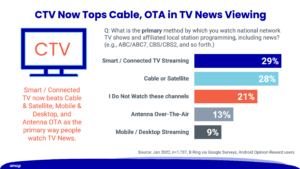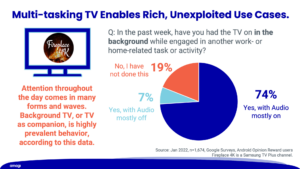
TV news finds new, creative frontier in streaming media

When Malaysia Airlines Flight 17 was shot down by a surface-to-air missile over Ukraine in 2014, amateur video of the incident, which claimed 298 lives, quickly emerged on YouTube and, once verified, got picked up by major TV news organizations.
For Micah Grimes, who was then a social media editor for ABC News, saw the event as “a big turning point” in the rise of streaming video.
“Just the speed at which that happened — the video was there, it was stunning, and then it went out on an ABC News special report to millions of people — it was just an amazing thing to see,” said Grimes during a recent TVNewsCheck webinar, “Live Linear Streaming and the Explosion of Innovation in TV News.”
Grimes, who today is VP of sports and news at Atmosphere TV, joined three other streaming media executives to talk about how their relatively new medium has spawned a wave of creativity in news storytelling and presentation.
Atmosphere, a new streaming TV service designed for businesses, such as restaurants, hotels and healthcare providers features “a lot of text-on-screen, a lot of UGC content,” Grimes said, and sometimes feels like scrolling through TikTok, which puts a priority on making the first three seconds of any story as compelling as possible, even if the segment is audio-free.
“We wanted to really lean into the future, here, which is streaming, and all the technology that that brings,” Grimes said. “But it’s also a combination of traditional TV, and marrying those two experiences.”
Operating in such a format — generating a “visual newspaper,” as he called it, for its news channel — does not require the overhead of control rooms or even on-air talent. Some consumer research the company has done indicates that people who watch Atmosphere
TV at their doctor’s office feel as though they’re spending less time in the waiting room.
“It entertains you,” Grimes said of the service.
No Filter, No Lens
LiveNOW from Fox, another streaming news channel, has been designed to meet two consumer demands: accuracy and immediacy.
Shareef Abul-Ela, VP and head of LiveNOW, said the concept grew out of necessity. During the height of the pandemic, viewers craved information on the response to COVID-19’s outbreak. Most importantly, because the story was so fluid and vital to safety, consumers wanted the updates in real time.
“Copying what’s already out there is the wrong move,” Abul-Ela said. “We wanted to change the concept of what news is to people right now.”
LiveNOW achieves this by leveraging the company’s local newsgroups, pulling programming options from its nationwide network of stations. Because it’s streaming and produced in real-time, customers expect and appreciate what Abul-Ela called LiveNOW’s “raw” presentation. (Oftentimes, timely news conferences will be aired in their entirety, live, for example.)
“There is no filter, there is no opinion, there is no lens,” he said. “We … deliver the information as it is, from front to back. We like to say, ‘We don’t believe in soundbites.’”
Data and Weather Storytelling
Sarah Katt, GM of the AccuWeather Network, said if there’s one thing her organization relies on most, it’s data.
“Data is clearly the secret sauce of AccuWeather,” Katt said. “[Our] backbone is visualizing weather data, explaining weather data, presenting weather data in the most compelling way possible. We do that in multiple ways. It’s part of our live video programming, our graphics and overlays, our storytelling. You really see it in every component of what we do.”

A recent survey of consumers found 19 percent preferred watching news on connected TV
Among the technologies the group relies on these days: cloud and HTML5 graphics, radar and API data. Katt also said one of the recent innovations her team was most excited about was the acquisition of a company that measures air quality. Programming will increasingly feature data about local air quality going forward.
“Data [is] the way we can customize and localize our presentations and really offer the viewer something that’s for them and has the most meaningful information presented,” Katt said.
Because weather affects every consumer, the AccuWeather Network also felt it appropriate to launch its own 24/7 live streaming channel, AccuWeather NOW, which is available on various digital platforms. Katt said much of its programming relies on expert interviews, but also revolves around “weather storytelling” as it affects different aspects of daily life.
“Everything from gardening to fishing to Women’s History Month, weather comes into play in almost every single thing that we do,” Katt said. “That’s what’s so fascinating about our vertical and why it has so much depth.”
Streaming News Gains Among Consumers
According to a poll conducted recently by the webinar’s moderator, Brian Ring, connected TV has become the leading source of news for 29 percent of consumers. That’s one percent higher than the number of people who watch news on cable or satellite, and 16 percent higher than the group who watch news on antenna/over the air TV. Mobile and desktop streaming is home to just nine percent of news consumers, said Ring,who is senior director of product marketing, news, for cloud provider Amagi.
Matthew Dominguez, senior manager of streaming distribution and partnerships at Cox Media Group, said his company regards CTV viewing as “additive.”
“We can reach viewers who maybe haven’t been with us in other places,” he said during the webinar. “Maybe they’re not somebody who has historically watched our news over the air. Maybe they’re younger. So we just see it as a great opportunity to reach the viewers wherever they are.”
Abul-Ela cited a Nielsen study from last year that revealed 81 percent of U.S. homes have at least one connected TV. He also said that the number of “cord-cutters” continues to grow.
“LiveNOW was just the opportunity to jump in with both feet into that space,” he added. “It’s really about that massive distribution. We have to be there. We have to get there.”
Channel Surfing Meets Connected TV
One of the emerging popular streaming options is Free Ad-Supported TV or FAST. Pluto TV, Samsung TV Plus and The Roku Channel rank among the bigger names in FAST, which includes services that offer both linear and on-demand programming, and are in some content-publishing circles highly regarded for being “app-less” or “in-the-glass” CTV options.
Dominguez said consumers like live linear streaming for counterintuitive reasons.

Consumers often use live linear streamed news as background or a companion while doing other things
“It brought back this idea of channel-surfing, flipping channels, looking through a guide,” Dominguez said. In spite of all the favorability of on-demand programming, consumers the past few years have grown overwhelmed with the choices at their fingertips. “It narrows down choices a little bit,” he continued. “You can find something that’s already on, and once you’re there, you might stick around and watch whatever comes next. As a programmer, that’s fantastic to see that, not only are people coming in, but it’s great for seeing that potential stickiness that happens once people start jumping into these FAST channels.”
The emergence of FAST creates a different experience for viewers than Ad-Supported Video On Demand (AVOD), another programming option, often seen on streamers in their non-premium subscription packages. But the panelists believe some combination of the two, and other possibilities, are probably the best way for publishers to approach digital programming.
“It’s about giving viewers the most choice,” Katt said. “We want our audience to be able to pick what they want… the ecosystem of creating AVOD assets with streaming together is really the best way to package content.”
Of course, if FAST or AVOD doesn’t sound appealing enough to publishers, there’s always subscription services, like the new CNN+, debuting this spring, with a price point of $5.99 per month, or $59.99 per year. The station will have live, on-demand and interactive programming.
Companion Viewing
Consumers continue to use their TVs as a companion, according to another survey from Ring, which found that 74 percent of viewers had kept their TV on “in the background,” during the past week while they were engaged in other activities. Katt said the AccuWeather Network builds in sound and visual cues to recapture viewer attention, but for passive viewers, the service defines itself as a “companion” broadcast.
“Some people are very engaged with our on-air meteorologist, and they really want to see that personality and feel like they’re having a dialogue with them,” Katt said. “Others really want that actionable, great, high-quality video.”
User experience is also critically important. “We use advance-study triggers to make sure ad breaks are going to be exact,” said Dominguez about Cox’s streaming programming efforts. “That way it creates a better user experience — you’re not going to miss any content, you’re not going to come back late, you’re not going to come in early.”
The procedure also reduces slate, which is also a major key in monetization, because it allows programmers to serve as many ads as possible, Dominguez said.
(He did observe that even slate is better than a black screen, which so often prompts users to leave.)
What’s Next?
In closing, Grimes and Katt said the next frontier for publishers in the streaming space is localizing and personalizing content. Abul-Ela predicted growth in the UGC realm, with viewers directly contributing to news coverage, while Dominguez said he expects continued improvements in the viewer experience overall.
Ultimately, as Grimes said, “It’s just figuring out the technology. That’s really all it is.”
Given the rate technology has grown in recent years, it won’t take long to see results, with high tides raising boats for viewers and content producers alike.
“It’s really exciting,” said Grimes about this moment in streaming news. “The things we’re building right now are going to be ‘duh’ in 10 years.”
For more on streaming news, download Amagi’s new “Winning in News” eBook, featuring ten unique datapoints and three case studies that tell the story about the explosion of innovative in streaming TV news.
































Comments (0)